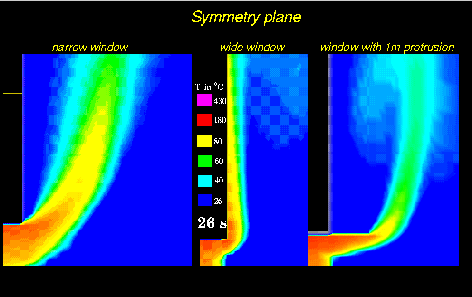FIRE PROPAGATION IN HIGH RISE BUILDINGS.
A method of fire propagation to higher floors in high rise buildings is via the outside of the building. The fire exits the incident floor through a window and spreads to higher floors as the flames and thermal plume rise through the effects of buoyancy. This phenomenon has been responsible for a number of devastating fires over the years such as the Andraus Building fire of Sao Paulo in 1972 and the MGM Grand hotel fire in 1980. A number of experimental studies have suggested many of the mechanisms by which this occurs. This work is concerned with the development of three-dimensional fire field models capable of describing this phenomenon.
The flow domain for the three-dimensional model measures 16.8m deep, 22.8m high and 22m wide. The building extends to the full height and width of the flow domain and the fire compartment - of dimensions 2.5m high, 4m wide and 4.75m deep - is centrally located in the building and on the third level above the ground. A symmetry plane passes through the centre of the building (and hence fire compartment) from top to bottom and back to front. The heat source was ramped to 1 MW and was centrally located on the floor of the room at the back wall. The flow domain was meshed with a non-uniform (essentially) cartesian grid comprising of 73,101 cells (59 * 59 * 21). The time step used was 0.5 seconds. The three-dimensional model was implemented using the University of Greenwich parallel version of FLOW3D and executed on a parallel computer comprising 12 Intel i860 processors.
Three window geometries were considered, narrow, wide and wide with a 1 m deep external protrusion at ceiling level. Of the three cases, the wide window geometry more closely corresponds to the two-dimensional case. These simulations clearly reveal the strongly three-dimensional nature of the flow. In the case of the wide window, the rising plume adheres to the wall surface as noted in the two-dimensional case. However, as we approach the end of the 'wide' window, edge effects become important and the plume becomes detached due to sideways entrainment. It is interesting to note that a similar scenario run on a coarse mesh of approximately 30,000 cells does not reveal the same degree of detachment. In the narrow window case, the ceiling jet emerging from the room is strongly ejected, resulting in the plume becoming completely detached from the external wall, allowing it to entrain air from all directions. This is in broad agreement with experimental observations. In the case with the protrusion, the plume, while detached for a short distance above the window, reattaches itself to the external wall. However, wall temperatures are considerably lower than those found in the wide window case.

FIGURE: Portion of 3-dimensional mesh showing plume propagation from (a) narrow, (b) wide and (c) wide with protrusion windows. Plane depicted passes through the centre of the window.
Reference:
CFD Analysis of Fire Plumes Emerging from Windows with External Protrusions in High-Rise Buildings. Authors: E R Galea, D Berhane, N A Hoffmann. Proceedings of the 7th Intern Fire Science and Engineering Conference: Interflam'96, pp 835-839, St John's College, Cambridge, England, March 1996, compiled by C Franks and S Grayson, Publ by Interscience Communications Ltd, London, UK, 1996. ISBN 0 9516320 9 4.
See publications # 89, 81, 77, 64

